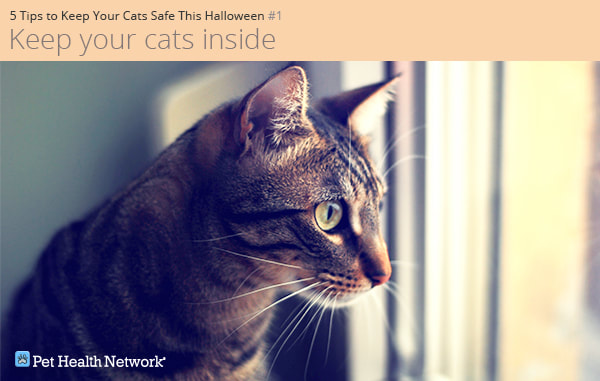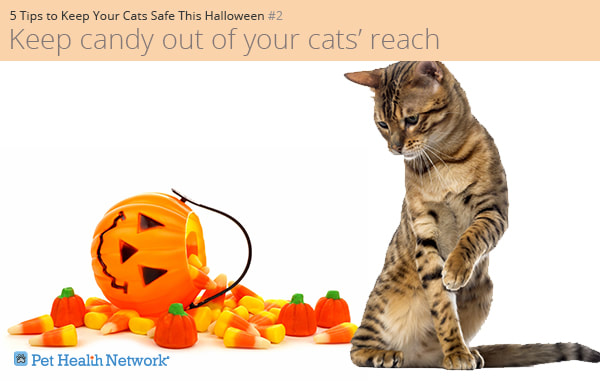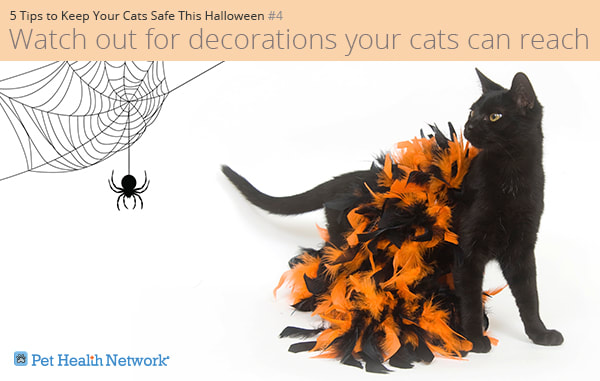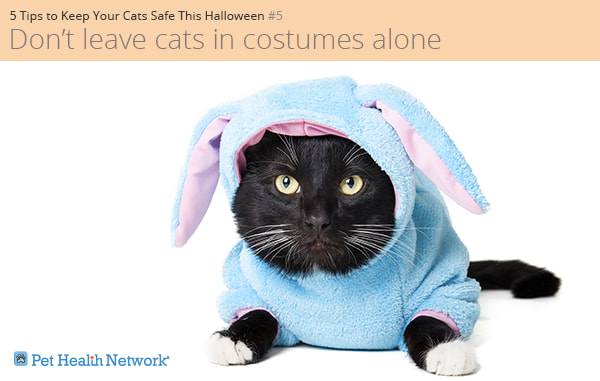|
Posts by: Dr. Ruth MacPete, DVM Halloween isn’t just a spooky time for humans; it can be frightening and even deadly for cats. As you prepare for Halloween, keep these five tips in mind, so that both you and your feline friends have a safe and happy Halloween. If your cats aren’t already indoor-only cats, be sure to keep them inside on Halloween night, so they are not terrified by all of the scary Halloween trick-or-treaters. With lots of scary noises and children in costumes shouting “Trick or Treat,” even indoor cats can become frightened. Many pets are lost each Halloween when they get scared and dart out of open doors, so keep your cats safe and away from the commotion by keeping them in a back room. Another reason to keep your cats indoors during Halloween is to protect them from people who wish to do them harm. Sadly, there has been a disturbing increase in the disappearance of many animals, especially black cats, during Halloween. Besides keeping your cats indoors, make sure your cats each have a collar, ID tag and microchip just in case they get out and become lost. Halloween candy can be very dangerous for cats, especially chocolate and xylitol! Most people think this is something only dog owners need to worry about, but unfortunately, cats occasionally eat candy too. Most people know that chocolate is toxic to pets and even small quantities can be fatal. Few people know that candy sweetened with xylitol, such as sugar-free gum, can also be very dangerous. Xylitol causes insulin release and low blood sugar levels and can lead to liver failure. Be sure to keep all Halloween candy away from your pets. If your cat manages to steal and eat candy, immediately call your veterinarian or take your cat to a veterinary emergency clinic. Jack o’ lanterns with flickering candles can be very attractive and dangerous to curious kitties. Besides burning an inquisitive nose or paw, candles can start a house fire if they are accidentally knocked over. To be safe, never leave lit candles unattended, always place them out of reach of all pets, and consider switching to safer, battery-powered “candles.” Blinking lights, stringy webs and other spooky decorations can also be dangerous to curious cats. Pets can become entangled in lights and stringy objects. Strings of twinkling Halloween lights can be quite attractive to your cats and can electrocute them if they nibble on the cords. Small decorations can be ingested and cause life-threatening intestinal blockages unless they are surgically removed. To be safe, make sure all decorations are safely out of reach of all pets. Some people, like me, love to dress their pets up for Halloween. Just be sure you use a costume made for cats and never leave them in a costume unattended. Pet costumes are made to fit pets and come off easily. However, never leave any of your pets alone in a costume as they can easily get into trouble. Some animals may decide to take their costume off themselves and become entangled, while others may get their costume stuck on something and choke. Make sure your cat is comfortable with a costume; if you believe it might cause any anxiety, check with your veterinarian first.
As you prepare for Halloween, keep these tips in mind, so that both you and your feline friends have a safe and happy Halloween.
25 Comments
Posts by: Tori Houle, Lifestyle Contributor and Junior Editor of PetHealthNetwork Just because the temperature is dropping, doesn't mean your dog wants to play inside now. One of Harley's favorite things do as the weather changes in play in the giant piles of leaves that fill up our yard. However, it's extremely important to be aware that tick season is not over. While you mostly find ticks in tall grass, they also lurk about in the leaves your dog loves to play in. So here's a simple reminder to always be checking your pets, as well as yourself for ticks year round! Ticks are terrible little parasites that carry multiple, nasty diseases that can affect both animals and people. Ticks are almost so common, people sometimes dismiss them as a concern, but it’s so important for pet parents to take ticks seriously. To protect your dog from tick-borne disease, it’s important you know where to be checking for ticks, and how often.
Ticks are still here While the weather is changing and our summer activities are winding down, that doesn’t mean ticks are going into hibernation. Some disease-carrying ticks have actually become immune to the cold because they’ve developed a type of anti-freeze glycoprotein to survive in harsh conditions. How scary is that? Read more about ticks and cold weather here >> Where should you be checking for ticks, and how often? When my dog Harley was diagnosed with Lyme disease 2 years ago, I knew I had to step my game up when it came to checking her for ticks. As demonstrated in the video above, Dr. Paul says that important places to check your dog include:
When should you be using tick preventives? The simple answer to this is always. Ticks are prevalent year-round. If you’re unsure about disease in your environment, check this map to see which canine vector-borne diseases are in your area >>Want more information on ticks? Here are some great resources: Ticks 101 >> Dogs, Ticks and Tick-Borne Parasites >> Protecting Your Dog from Fleas and Ticks >> 6 Tick-Borne Diseases You Should Know About >> If you have any questions or concerns, you should always visit or call your veterinarian -- they are your best resource to ensure the health and well-being of your pets. Reviewed by: Dr. Alexis Seguin, DVM, MS, DACVIM |
Archives
November 2023
Categories |
|
HELPFUL INFORMATION
Office Hours
Monday: 8AM – 6PM Tuesday: 8AM – 6PM Wednesday: 8AM – 8PM Thursday: 8AM – 8PM Friday: 8AM – 5PM Saturday: 8AM - 12PM Sunday: CLOSED |
LOCATION
AND DIRECTIONS Salem Veterinary Hospital
2159 Lynnhaven Parkway, Suite 105B Virginia Beach, VA 23456 |
CONNECT
WITH US! |
Site powered by Weebly. Managed by IDEXX Laboratories





 RSS Feed
RSS Feed
